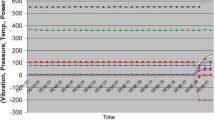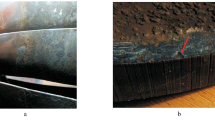Abstract
The chemical analysis of the material used for this forging met all requirements of the specification. Mechanical tests of the specimens taken from the outside and at mid-radius of the forging also met the specification requirements. Test specimens taken near the bore tended to have lower yield and tensile strengths and frequently had very low ductility. Some reduction of ductility is to be expected at the center of a heavy mass, but in this case the reduction was considered to be excessive. The fractures of some of the deep-seated specimens contained fisheyes. Tests of duplicate specimens that had been heated to a low temperature, 400°F, resulted in normal ductility. Fisheyes and low ductility, which may be considerably improved by a low temperature heat-treatment, are typical effects of large amounts of hydrogen in steel. Macroex-amination of the forging indicated that the main body contained approximately 5000 cracks. These cracks were generally oriented in radial planes with their maximum dimensions in the longitudinal direction. They occurred most frequently in zones of sulfur segregation in the main body of the forging. These cracks are believed to be flakes produced while the forging was cooling from a high temperature or while it was standing at room temperature after such cooling and prior to a tempering or stress-relieving heat treatment. Flakes are generally considered to be caused by thermal transformation stresses combined with severe reduction in ductility caused by the collection of gaseous hydrogen under high pressure within imperfections in the steel. No cracks were observed in the portions of the shaft extensions which were forged to relatively small diameters. Apparently cracks did not occur in these smaller sections because the transformation stresses were lower and possibly because more of the hydrogen could diffuse from these smaller sections than from the main body.
Ultrasonic reflectoscope indications observed in examination of the failed spindle were very similar to those observed at the time the forging was made. It must be concluded, therefore, that the thermal cracks or flakes were present at the time the forging was first inspected and that the ultrasonic indications were from flakes rather than from inclusions.
It is believed that the fatigue crack that developed at the fillet between the generator end shaft extension and the main body was not a factor in this failure. Assumption of the fatigue crack as the origin of failure would not lead to the symmetrical pattern of failure which was observed. Origin of the fatigue crack was identified as a thermal crack or flake that happened to occur in the fillet between the shaft extension and the main body. This fillet was the location of moderate. stress concentration, and the additional stress concentration owing to the flake resulted in development of the fatigue crack.
Detailed examination of the fractured pieces indicated that failure began in the plane shown in Fig. 5 at or near the bore toward the turbine end of the main body. The assumption of this origin of failure leads to a consistent sequence of failure and explains the high degree of symmetry of the broken parts. It is believed that the large number of thermal cracks or flakes within the spindle was the primary cause of failure.
Although this was a serious failure, much has been learned from it. It is now possible to interpret tests much more accurately, and it should be possible to avoid such accidents in the future. Changes in practice in the manufacture of such forgings should also avoid hydrogen solution and subsequent cracking.
Similar content being viewed by others
Author information
Authors and Affiliations
Rights and permissions
About this article
Cite this article
Matters, R.G., Lochen, R.E., Dedinas, J.A. et al. Industry Learns From a Turbine Spindle Failure. JOM 8, 317–324 (1956). https://doi.org/10.1007/BF03377690
Published:
Issue Date:
DOI: https://doi.org/10.1007/BF03377690




